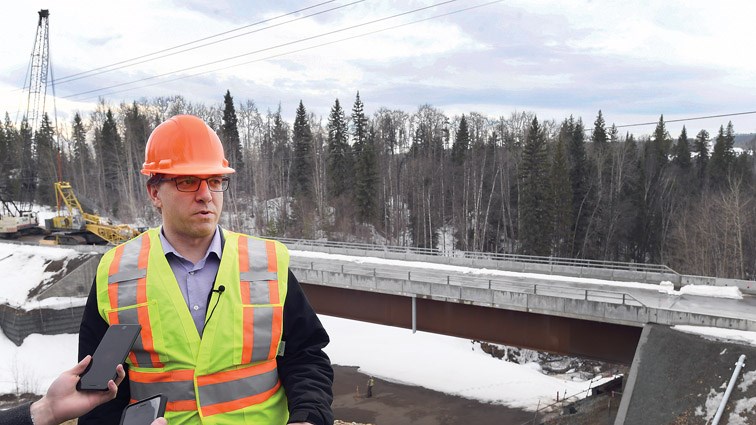City council voted unanimously Monday night to borrow a total of $8.5 million to pay for two projects that hit the city with some unexpected expenses but not before expressing plenty of frustration with the situation.
Of the total, $6.8 million is for work on a bridge on Willow Cale Road where it crosses Haggith Creek that forced closure of the stretch for a significant amount of time and caused inconvenience to commuters in the process.
Another $1.7 million is for extensive work the city hopes has put an end to the re-emergence of a sinkhole on Winnipeg Street at 20th Avenue, which also forced commuters to alter their routes.
The escalating cost of work on the bridge in particular drew sharp words.
"In my opinion, somebody's got to be held responsible," Coun. Brian Skaun said. "We are held responsible every four years and in this case there is obviously some mistakes made."
Coun. Terri McConnachie gave similar remarks, saying it's money that otherwise could have been spent on other items such as sidewalks and playgrounds.
"And yes, this is a deliberate shot across the bow because I think the way this turned out and the additional costs, with all those experts involved, is really just simply unacceptable," McConnachie said.
"I don't know where to go from here but once again we have to pay the bill. We can't not pay the bill, we're forced to. We can't go back and redo it but I sure wouldn't want to see this type of debacle moving forward again."
By that time, city manager Kathleen Soltis had joined city engineering director Adam Homes at centre table to field questions and comments from council.
When a culvert that had been in place since the road was built more than 50 years ago began to fail, it was decided that a bridge over the creek should be constructed in answer to the depth of the crossing and because the creek is fish bearing.
Construction began in September 2016 and the bridge opened on March 30, 2017. But by early August 2017, cracks appeared in the new asphalt on the south side of the bridge, indicating unstable ground beneath.
The culprit turned out to be an unstable layer of clay about 20 metres below the surface that was undetected in a geotechnical survey.
The crossing was closed for a further 10 months and, on top of the $3.1 million that had been approved for the project, another $3.7 million was spent to get the crossing into proper shape. It was reopened in July 2018 and has remained that way since then.
Other councillors were not as confrontational.
Coun. Frank Everitt said it's "not always the case" that there is anyone to blame.
"If the ground shifts, that's not your responsibility, that's not my responsibility, that's just an act that happened out there in the ground and we have to live with the results of that," he continued and added that staff did what they did with the time they had to get the road back in shape.
"I don't like the difference in price. Nobody likes the difference in price but that's what is cost for us to do it," Everitt concluded.
Led by Skakun, council members also quizzed Homes over the possibility that more work will be in order because the site is not up to Department of Fisheries and Oceans standards due to an undersized culvert.
Homes said DFO will eventually want the city to remove the culvert "but we're saying that for public safety, for the time being that culvert can't move." He added that while the remediation work was being carried out the ground moved again and, in response, more fill was put on top of the culvert.
"That ground needs to consolidate. That could take years and years to happen," Homes said.
He said a properly-sized culvert could not be found while the project was underway.
Staff met with DFO officials on Tuesday to discuss the matter. In the aftermath, city spokesman Mike Kellett said the city will continue to monitor the fish habitat in the area.
"In the interests of public safety, the culvert will remain in place," he added.
Willow Cale Road was originally a forest service road owned by the provincial government. The city took it over in the early 2000s on the condition that the provincial government pave it first to help reduce the city's dust problem.
Trouble at the crossing was not noticed for another eight years or so, city engineering and public works director Dave Dyer told council.
City finance director Kris Dalio said the money needs to be borrowed to free up cash flow while the city waits for revenue from property taxes to come in.
The $8.5 million will be borrowed over five years. Debt servicing will amount to $1.83 million per year, adding up to $9.17 million over that time for a difference of $664,686 over and above the principal. Spread over five years, that works out to $132,937 per year or 1.56 per cent in interest, according to Citizen calculations.
Debt servicing on the first $3.7 million for the bridge has been incorporated into the 2019 budget while the remaining will be folded into the 2020 budget, delivering an estimated 0.95 per cent increase to the tax levy.
A term for longer than five years is not possible as elector assent would be required and the projects have already been completed, according to staff.



